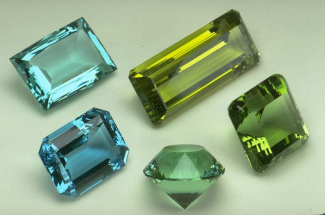Seven of the ten major Bible versions used for comparison purposes in this series translate this word as "beryls," with the HBFV, NCV and NIV calling it a "chrysolite."
Tarshiysh or beryls are also listed as the fourth stone that adorned Lucifer, before he became God's enemy (Ezekiel 28:13), in order to make him appear radiant and beautiful. The NLT translation calls them a blue-green variety of the stones, with the NCV calling it a "yellow quartz" and the New International Version Bible referring to it as a "chrysolite."
The eighth foundation gemstone in the New Jerusalem (Revelation 21:20) is called, in the Greek, berullos (Strong's #G969). Strong's translates the word as "beryls." Thayer's lexicon defines the word as referencing beryls, the same as Strong's, but also states this precious stone displays a pale green color.

Tarshiysh is also mentioned in the Bible in Song of Solomon 5:14, Ezekiel 1:16, 10:9 and Daniel 10:6. In Ezekiel's well-known "wheel in a wheel" vision of God's glory and throne, he sees things colored like a beryl stone.
The appearance of the wheels and their workmanship was the color of beryl, and the four of them had the same likeness. And their appearance and their workmanship was like a wheel inside of a wheel (Ezekiel 1:16, HBFV).
Several color varieties of this gemstone are known to exist. Emeralds are a deep green variety of this type of stone. Other color varieties include yellow (Heliodors), pink or a touch of rose color (Morganite), a blueish green (Aquamarine) and colorless (Goshenite).
Beryls in the priest's breastplate might have been a pale-yellow colored variety known as the Golden Beryl, which is known to contain very few flaws.
Folklore
According to "Diamonds, Pearls and Precious Stones" (page 66), in the Middle Ages, beryls were thought to induce cheerfulness upon the wearer. It was commonly referred to as the "sweet-tempered" stone. Beryls was also believed to protect a person in battle, cure them of being lazy, and reawaken a married couple's love (Curious Lore of Precious Stones, pages 59 - 60).